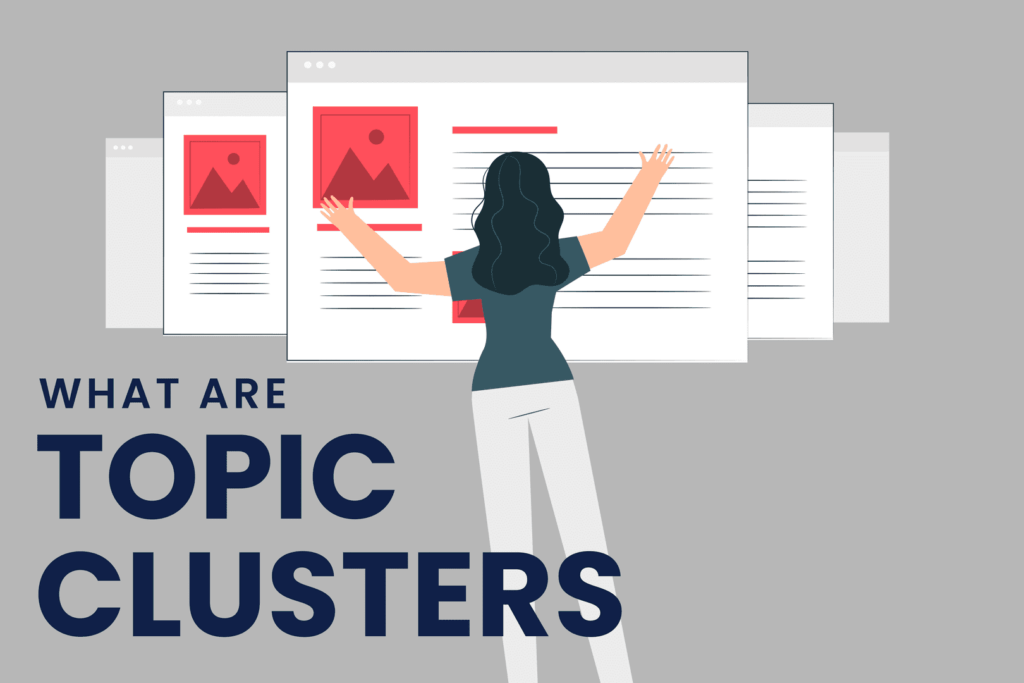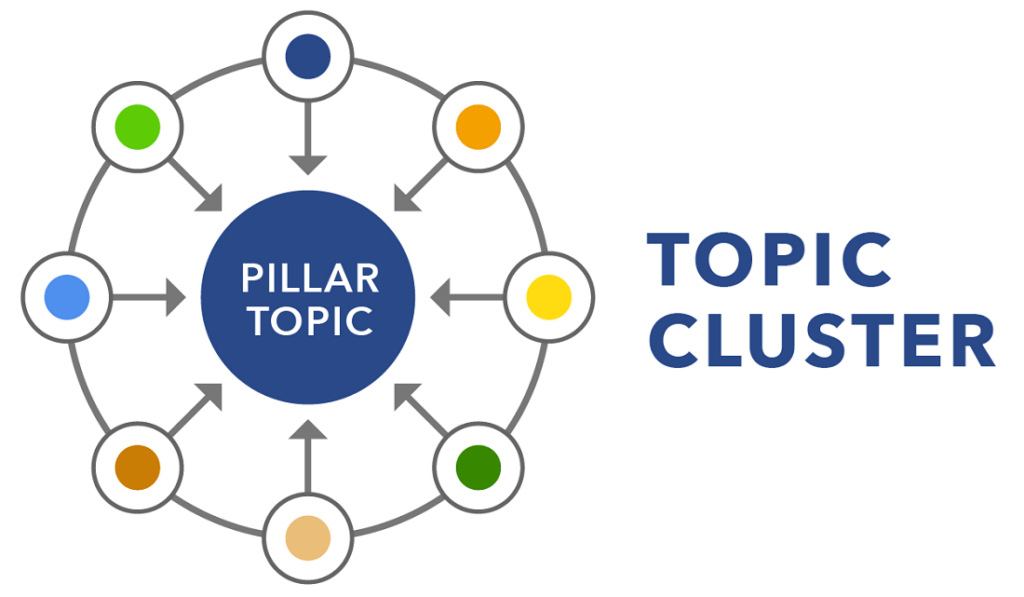Topic Clusters
Introduction to Topic Clusters
Topic clusters are a grouping of content that focuses on a central topic or theme. They are designed to help search engines understand the relationship between content and provide a better user experience for website visitors. By organizing your content into topic clusters, you can create a more comprehensive and cohesive website optimized for search engines.
Why Topic Clusters are Important for SEO
There are several reasons why topic clusters are essential for SEO. Here are a few:
- Improved User Experience: Organizing your content into topic clusters creates a more user-friendly experience for website visitors. When users arrive on your website, they can easily navigate to related content they are interested in, making it easier to find what they’re looking for.
- Better Search Engine Visibility Topic clusters can also help improve your search engine visibility. When you create a set of content that revolves around a central topic, search engines such as Google can more easily understand the context of your content. This can help your content rank higher in search engine results pages (SERPs).
- More Opportunities for Backlinks When you create a cluster of content around a central topic, you have more opportunities for other websites to link to your content. Backlinks are an essential factor in SEO, and by creating high-quality content related to a specific topic, you increase your chances of earning backlinks from other websites.
Creating a Topic Cluster Strategy
To create a successful topic cluster strategy, it’s essential to follow a specific process. Here are the steps to follow:
- Conducting Keyword Research The first step in creating a topic cluster strategy is to conduct keyword research. Keyword research involves identifying the words and phrases your target audience searches for on search engines like Google. This information can help you understand the topics your audience is interested in and create content relevant to their needs.
- Once you’ve conducted keyword research, the next step is identifying core topics for your cluster clusters. Core topics are broad topics that are relevant to your business or industry. For example, if you run a blog about health and wellness, your core topics might include fitness, nutrition, and mental health.
- Building Out Subtopics Once you’ve identified your core topics, it’s time to build out subtopics. Subtopics are more specific than core topics and help to provide additional context and detail to your content. For example, if your core topic is fitness, your subtopics might include weightlifting, yoga, and cardio.
- Mapping Out the Topic Cluster The final step in creating a topic cluster strategy is to map out your topic clusters. Mapping out your topic clusters involves organizing your core topics and subtopics into a hierarchical structure that makes sense to users and search engines. This structure helps to show the relationship between different pieces of content and can help to improve the user experience.
When mapping out your topic cluster, you should identify which core topic will be the central hub for your content. This central hub should be linked to all of the relevant subtopics and should link back to each subtopic. This interlinking helps signal to search engines that the content is related and can help improve your rankings.
It’s important to note that creating a topic cluster strategy is an ongoing process. As you create new content, you should continue to update and refine your topic clusters to ensure they remain relevant and practical.
Creating a topic cluster strategy is an essential part of any SEO strategy. Following the steps outlined above, you can create a comprehensive and cohesive content strategy optimized for search engines, providing a better user experience for your website visitors.
Writing Content for Topic Clusters
Once you’ve created a topic cluster strategy, the next step is to write content for your topic clusters. Here are the steps to follow:
Writing Content for Core Topics
The first step in writing content for your topic clusters is to focus on the core topics. Core topics are broad topics relevant to your business or industry. When writing content for core topics, you should aim to create comprehensive and authoritative content that provides a high-level overview.
For example, if your core topic is fitness, you might create a comprehensive fitness guide covering different types of exercises, nutrition, and mental health. This content should be well-researched, well-written, and provide value to your audience.
Creating Content for Subtopics
Once you’ve created content for your core topics, it’s time to focus on the subtopics. Subtopics are more specific than core topics and help to provide additional detail and context to your content.
When creating content for subtopics, you should aim to provide in-depth information relevant to your audience. For example, if your core topic is fitness and your subtopic is weightlifting, you might create content that covers different weightlifting techniques, equipment, and safety tips.
Interlinking Content in the Topic Cluster
One of the critical benefits of topic clusters is that they allow you to interlink your content. Interlinking your content helps to show the relationship between different pieces of content and can help to improve your search engine rankings.
When interlinking your content, you should link from your subtopic content to your core topic content and vice versa. This helps to create a web of related content that search engines can easily understand.
It’s important to note that the content you create should be high-quality and provide value to your audience. Your content should be well-written, well-researched, and provide actionable advice for your audience.
Writing content for topic clusters is an essential part of any SEO strategy. By focusing on your core topics, creating in-depth content for your subtopics, and interlinking your content, you can make a comprehensive and cohesive content strategy optimized for search engines and provides value to your audience.
Optimizing Topic Clusters for SEO
Once you’ve created content for your topic clusters, it’s time to optimize them for search engines. Here are the steps to follow:
On-Page Optimization
On-page optimization involves optimizing the content on your website to make it more visible to search engines. Here are some on-page optimization techniques you can use for your topic clusters:
- Use descriptive and relevant meta titles and descriptions for each page
- Include your target keyword in the URL, title tag, and header tags
- Use internal linking to connect related pages within your topic cluster
- Optimize your images by using descriptive file names and alt tags
Off-Page Optimization
Off-page optimization involves optimizing your website’s reputation and authority to improve your search engine rankings. Here are some off-page optimization techniques you can use for your topic clusters:
- Earn backlinks from authoritative websites by creating high-quality content that provides value to your audience
- Use social media to promote your content and increase your website’s visibility
- Engage with your audience by responding to comments and answering questions
Measuring Success
Measuring the success of your topic clusters is an essential part of optimizing them for SEO. Here are some metrics you can use to measure the success of your topic clusters:
- Organic traffic: Track the amount of traffic that comes to your website from search engines
- Keyword rankings: Track the order of your target keywords in search engine results pages (SERPs)
- Engagement metrics: Track the number of comments, shares, and likes your content receives on social media
By measuring these metrics, you can identify areas for improvement and adjust your topic cluster strategy accordingly.
It’s important to note that optimizing your topic clusters for SEO is an ongoing process. You should continually update and improve your content to ensure it remains relevant and provides value to your audience.
Optimizing your topic clusters for SEO is integral to any content strategy. By following the on-page and off-page optimization techniques outlined above and measuring the success of your topic clusters, you can create a comprehensive and effective content strategy optimized for search engines that provides value to your audience.
Advanced Topic Cluster Tactics
To take your topic cluster strategy to the next level, you can use advanced tactics to optimize and promote your content. Here are some advanced topic cluster tactics:
Updating and Refreshing Content
One advanced tactic is to update and refresh your existing content. Updating your content with new information can improve its relevance and usefulness to your audience. Restoring your content can also help to improve its search engine rankings.
To update and refresh your content, you should review your existing content regularly and look for opportunities to add new information or improve its structure. You should also update any outdated information and ensure your content is up-to-date with the latest trends and best practices.
Repurposing Content Across Channels
Another advanced tactic is to repurpose your content across different channels. Repurposing your content can help you reach new audiences and increase your website’s visibility.
For example, you can turn a blog post into a video or a podcast episode. You can also share your content on social media platforms like Facebook, Twitter, and LinkedIn. By repurposing your content across different channels, you can reach more people and increase your website’s traffic.
Analyzing and Adjusting the Topic Cluster Strategy
The final advanced tactic is to analyze and adjust your topic cluster strategy. By analyzing your topic clusters, you can identify areas for improvement and adjust your plan accordingly.
You should track key metrics like organic traffic, keyword rankings, and engagement metrics to analyze your topic clusters. It would help if you also looked for opportunities to expand your topic clusters by identifying new core topics and subtopics relevant to your audience.
Once you’ve analyzed your topic clusters, you can adjust your strategy by creating new content, optimizing existing content, and repurposing content across different channels. By continually analyzing and adjusting your topic cluster strategy, you can create a comprehensive and effective content strategy optimized for search engines and provides value to your audience.
Advanced topic cluster tactics can help you take your content strategy to the next level. By updating and refreshing your content, repurposing your content across different channels, and analyzing and adjusting your topic cluster strategy, you can create a comprehensive and effective content strategy optimized for search engines that provides value to your audience.
Conclusion
Topic clusters are an essential part of any SEO strategy. By organizing your content into topic clusters, you can create a comprehensive and cohesive website optimized for search engines and provides a better user experience for your audience.
Here are some key takeaways about topic clusters:
- Topic clusters are a grouping of content that focuses on a central topic or theme.
- Topic clusters can improve the user experience, increase search engine visibility, and provide more opportunities for backlinks.
- To create a topic cluster strategy, you should conduct keyword research, identify core topics, build out subtopics, and map out the topic cluster.
- When writing content for your topic clusters, you should focus on your core topics, create in-depth content for your subtopics, and interlink your content.
- To optimize your topic clusters for SEO, you should use on-page and off-page optimization techniques and measure your success with metrics like organic traffic and keyword rankings.
- Advanced tactics like updating and refreshing your content, repurposing your content across different channels, and analyzing and adjusting your topic cluster strategy can help you take your content strategy to the next level.
Topic clusters are an essential part of any content strategy. By following the steps outlined in this article, you can create a comprehensive and effective content strategy optimized for search engines that provides value to your audience. Remember to continually update and refine your topic clusters to remain relevant and practical.
F.A.Q
What is the use of topic clusters?
The use of topic clusters is to organize your website’s content around a central topic or theme. Topic clusters help search engines understand the relationship between content and provide a better user experience for website visitors. Organizing your content into topic clusters creates a more comprehensive and cohesive website optimized for search engines.
The primary goal of using topic clusters is to improve your search engine rankings by providing relevant and high-quality content organized in a way that is easy for search engines and users to navigate. By creating a web of related content, you signal to search engines that your website is an authoritative source of information on your industry or topic. This can help you rank higher in search engine results pages (SERPs) and drive more organic traffic to your website.
In addition to improving search engine visibility, topic clusters can also enhance the user experience on your website. Organizing your content into topic clusters makes it easier for users to find the information they’re looking for and explore related topics relevant to their interests. This can help to increase user engagement and improve the overall user experience on your website.
Overall, using topic clusters is an essential part of any content strategy. By organizing your content into topic clusters, you can create a comprehensive and effective content strategy optimized for search engines and provides value to your audience.
How do you identify a topic cluster?
To identify a topic cluster, you should start by conducting keyword research. Keyword research involves identifying the words and phrases your target audience searches for on search engines like Google. This information can help you understand the topics your audience is interested in and create content relevant to their needs.
Once you’ve conducted keyword research, you can use the following steps to identify a topic cluster:
- Identify the Core Topic: Look for a broad topic relevant to your business or industry. This core topic will serve as the central hub for your topic cluster.
- Identify Subtopics: Look for more specific topics related to your core topic. These subtopics will provide additional context and detail to your content and help to create a web of related content.
- Determine the Relationships Between Topics: Look for the relationships between your core topic and subtopics. These relationships will help you organize your content and create a hierarchical structure that is easy for search engines and users to navigate.
- Create a Map of Your Topic Cluster: Once you’ve identified your core topic and subtopics, create a map of your topic cluster that shows the relationships between different pieces of content. This map will help you organize your content and ensure it is optimized for search engines.
Overall, identifying a topic cluster requires careful research and planning. By following the steps outlined above, you can create a comprehensive and practical topic cluster optimized for search engines and provides value to your audience.






